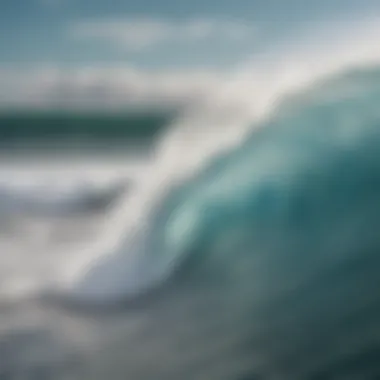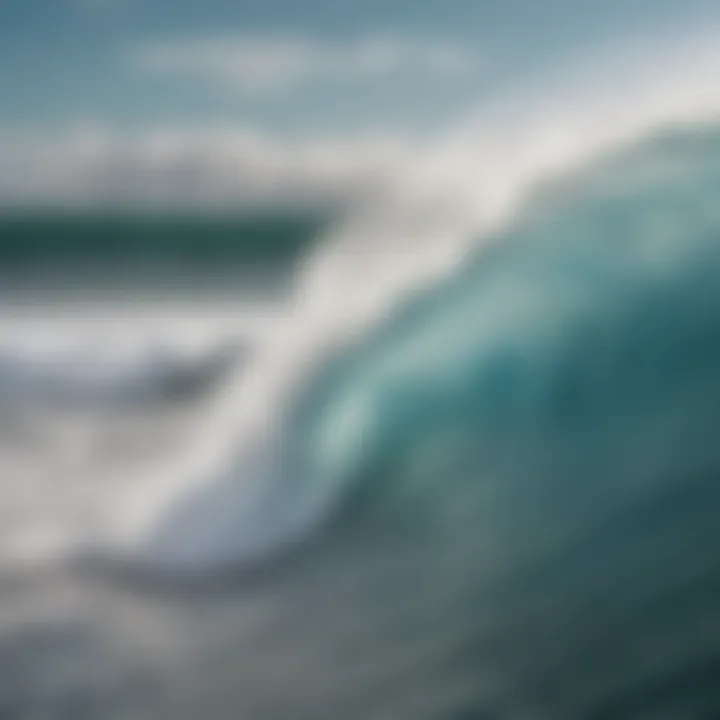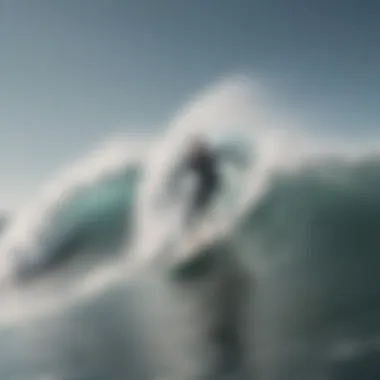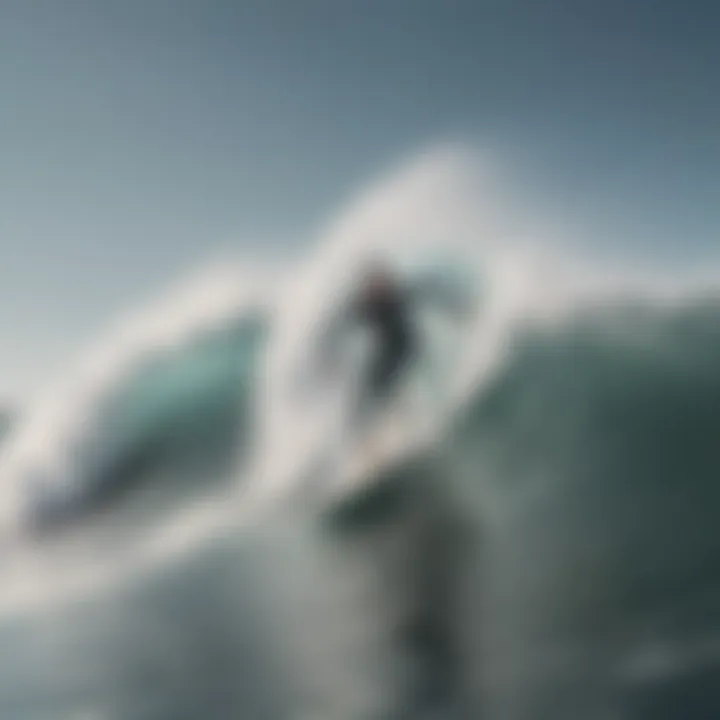Harnessing the Wind: Insights into Wind Guru


Intro
The wind has always held a profound influence over the ocean. For surfers, understanding how wind patterns affect waves can mean the difference between catching that perfect ride or coming up empty-handed. This article brings to light the concept of Wind Guru, a valuable resource for surfers looking to optimize their time spent on the water. With comprehensive insights into wind forecasting, the intricacies of surf conditions, and an overview of essential tools, readers will find a wealth of knowledge, whether they are novices just beginning to dip their toes in or seasoned surfers chasing the next big wave.
Wind forecasting provides critical information that helps surfers decide where and when to surf. Accurate predictions can lead to exciting surf days, while incorrect assumptions could lead to frustrating and even hazardous conditions. By grasping the core ideas behind wind patterns, surfers can make informed decisions, maximizing their overall surfing experience.
In this exploration, we will also touch on the range of surfboards available, suitable for diverse skills and styles, and highlight some essential surfing techniques, both for beginners and experienced riders. Whether you're paddling out at dawn or riding the last sets of the evening, understanding wind conditions can enhance the experience, keeping both safety and enjoyment at the forefront.
Let’s embark on this journey to harness the wind, starting with a critical look at the gear that makes it all possible.
Understanding Wind Patterns
Understanding wind patterns is akin to possessing a map of invisible currents that significantly influence our environment, particularly when it comes to surfing. Gaining insights on how wind operates enables enthusiasts to read ocean dynamics, allowing surfers to predict optimal conditions for riding the waves. It further underscores the essential relationship between wind and water, enhancing safety and enjoyment on the surf.
The movement of air interacts with various geographical features, creating a tapestry of conditions that can amplify or dampen wave formation. Therefore, grasping these underlying principles is crucial for any surfboarder looking to ride the crest of a wave, or at least avoid faceplanting into one.
The Science Behind Wind
Formation of Wind
The formation of wind is the driving force of many weather phenomena. Wind arises primarily due to uneven heating of the Earth’s surface by the sun, resulting in pressure differences. The key characteristic here is that warmer air rises, creating an area of lower pressure. Meanwhile, cooler air rushes in to fill the void, resulting in what we generally experience as wind. This process plays a vital role in shaping the conditions vital for surfers.
One unique feature of wind formation is that it’s not just about temperature; various geographical factors, such as mountains and bodies of water, can dictate local breezes and gusts. Understanding this can be particularly advantageous for predicting how a day at the beach will unfold. Some surfers might prefer the strong offshore winds that groom the waves while others may seek the onshore breezes that create more challenging surf conditions.
Types of Wind
Diving deeper into types of wind, we find a category system that helps in understanding their characteristics. There are gentle breezes, strong gales, and everything in between. The prevailing winds, which tend to blow in the same direction regularly, are especially important for surfers. They can dictate wave size and shape, thus impacting the overall surf experience.
Commonly, surfers look up the trade winds and westerlies because of their reliability in wave generation. A unique aspect of these winds is their predictability—once you catch the patterns, you can time your surfing sessions for optimum economic use of your time. On the flip side, the sudden shifts in weather can put a damper on plans, making it essential to keep an eye on forecast changes.
Factors Affecting Wind Patterns
The factors affecting wind patterns merge to present a clearer picture of how the atmosphere operates. Temperature variances, geographical terrains, and seasonal changes create a dynamic environment that constantly shifts. The interplay among these elements is what makes weather forecasting both fascinating and, at times, unpredictable.
A prominent characteristic to highlight is that factors like humidity can drastically change wind behaviors, thus influencing wave conditions. For instance, an increase in humidity may lead to lighter winds, which might not favor surfing conditions. The unique interdependence of these factors provides a compelling reason for surfers to stay informed about local and global weather phenomena.
Historical Context of Wind Study
Early Research and Discoveries
The early research into wind patterns lays the groundwork for the more sophisticated understanding we have today. Ancient cultures often depended on observational techniques to chart wind behaviors, passing down knowledge for generations. From mariners relying on the winds to navigate to terrestrial dwellers understanding local climates, these early discoveries set the stage for modern meteorology.
A valuable aspect of this early research was the relational understanding of wind’s effects on both landscapes and human activities, marking it as a beneficial endeavor for progress. One unique feature of this historical perspective is that scientists like Aristotle and Benjamin Franklin contributed to recording these patterns, each in their own right—offering a window into the evolution of scientific thought.
Impact on Navigation and Exploration
Wind's impact on navigation and exploration cannot be overemphasized. The discovery of wind patterns allowed sailors to master the seas, revealing critical routes that transformed trade and exploration. For surfers studying these ancient practices, the understanding of consistent winds not only showcases a historical advantage but also highlights a survival skill that remains relevant today.
Key in this narrative is the introduction of the compass and celestial navigation, which combined with wind knowledge, revolutionized seafaring. One downside is that reliance on wind for navigation could sometimes lead to disastrous journeys if conditions turned unfavorable. Yet, this historical context emphasizes the necessity that still exists for today’s surfers to remain constantly aware of wind patterns when hitting the waves.
"Now, with tools like Wind Guru, navigating these important atmospheric elements has become a walk in the park—if only the weather would cooperate!"
Wind Forecasting Technologies
In the realm of surfboarding and outdoor activities, understanding wind patterns is paramount. Wind forecasting technologies have revolutionized how surfers, instructors, and marine biologists anticipate conditions on the water. Having access to accurate wind predictions not only enhances the enjoyment of surfboarding but also ensures safety on the waves. There’s a whole world of technological advancements that facilitate real-time wind assessment and offer insights tailored to specific locations and activities. With tools like Wind Guru, surfers can feel more in control of their experience, adapting their plans according to wind conditions.
Foreword to Wind Guru
Origin and Development of Wind Guru
Wind Guru was conceived in a quest to provide reliable surf forecasts by a team of passionate wind and wave enthusiasts over a decade ago. The developers identified a gap in practical, user-oriented forecasting tools that cater specifically to surfers and other wind-dependent activity practitioners. The site gives surfers a refined lens through which to view meteorological data, cherry-picking relevant information essential for planning.
An outstanding aspect of Wind Guru's development is its commitment to community feedback and continuous updates. Unlike many other forecasting platforms, Wind Guru pays close attention to the needs of its users—making adjustments based on what surfers find helpful. Such dedication sets it apart in an ocean of predictive tools; this responsiveness demonstrates a beneficial choice for anyone keen on staying informed about localized conditions. The advantages of having a dedicated service focused on surf conditions means surfers are often much better equipped to make decisions before heading out.
Unique Features and Offerings


The uniqueness of Wind Guru lies in its combination of real-time data access and a user-friendly interface. The platform specializes in providing various data points, such as wind speed, direction, and wave height—these factors are critical for determining when and where to surf. Beyond mere data delivery, Wind Guru offers visual forecasts with detailed charts that make interpretation easy, even for newcomers.
What really shines with Wind Guru is the ability to set location-based alerts. Users can choose specific surf spots to monitor, receiving notifications about wind changes or optimal conditions tailored to their preferences. This level of customization is a significant asset, allowing surfers to maximize their time on the waves while avoiding the pitfalls of unreliable forecasts.
How Wind Predictions Are Made
Data Collection Techniques
When it comes to wind predictions, the accuracy of the data collected is a foundational element. Wind Guru employs several techniques to gather atmospheric data, including satellite imagery, weather stations, and automated buoys stationed over the ocean. Each of these sources contributes to creating a comprehensive view of current wind conditions.
The key characteristic of these collection methods is their reliability and coverage. With a wide-ranging network of data sources feeding into the system, Wind Guru ensures that it can provide localized wind reports. This meticulous approach is beneficial because it means predictions are not based on generalized models, but rather on precise measurements that reflect the true state of the atmosphere.
While relying on automated systems allows for real-time updates, one downside is the possible variability in data accuracy based on sensor maintenance and geographical limitations. If equipment is not well-calibrated or if there are gaps in geographical coverage, the overall prediction may suffer. But for most locations, the robust system combines to form a reliable resource for surfers.
Modeling and Simulation Methods
Once data is collected, the next step is utilizing modeling and simulation techniques to interpret it effectively. Wind Guru employs a range of meteorological models to process the raw data and generate forecasts. These models account for various dynamical atmospheric processes, aiming to provide coherent outcomes that help predict wind behavior.
The primary characteristic of these methods is their capability to analyze complex interactions between different atmospheric variables. By simulating conditions over time, the models can produce fairly accurate predictions for short-term forecasts. Such functionality is especially valued by surfers, who often need to make quick decisions based on changing weather.
One major advantage of these modeling techniques is their forward-looking nature—they allow surfers to anticipate conditions. However, a point of consideration is that while models are powerful, they are not foolproof. Factors like localized weather events or unexpected atmospheric shifts can yield predictions that sometimes miss the mark, illustrating that while modeling is beneficial, it is always wise to verify conditions through multiple sources.
Accuracy of Wind Forecasts
Evaluating Forecast Precision
Evaluating the precision of wind forecasts is crucial to building trust among users. Wind Guru provides a feedback mechanism, allowing users to report their own observations against what the forecast predicted. Such a community-based approach leads to continuous improvement and more accurate models over time.
The striking element in evaluating forecast precision is the active involvement of the surfing community. Engaging users in this manner not only fosters a sense of ownership over the predictions but also enriches data with real-world confirmations. This aspect marks Wind Guru as a meticulous choice for surfers—ensuring the forecasts remain grounded in actual experience.
Nonetheless, it’s essential to recognize that all forecasts come with a degree of uncertainty. Factors such as sudden weather changes or microclimate effects can lead to discrepancies, underlining the importance of understanding that not every prediction will perfectly match real-time events.
Limitations and Challenges
Despite advances in wind forecasting technologies, challenges remain present. Wind Guru, while offering many unique features, faces limitations regarding regional accuracy and dependency on technology. For instance, areas with sparse data collection points may find forecasts less reliable compared to locations with dense meteorological networks.
Understanding these challenges is critical, especially for safety-conscious surfers aiming for optimal conditions. What sets Wind Guru apart is its transparency regarding these limitations. The platform allows users to assess the reliability of specific forecasts based on historical data and user feedback. This engenders a greater understanding and appreciation among users, which is vital when one’s safety and enjoyment depend on accurate wind and weather predictions.
Importance of Wind in Surfboarding
When it comes to the art of riding waves, the wind is quite a player, holding the reins in determining not only the surf conditions but also the overall experience for surfers. Understanding the dynamics of wind can mean the difference between catching that sweet wave or a frustrating day at sea. Wind plays a pivotal role, influencing not just the size and shape of the waves, but also their rhythm and consistency. With every gust and shift, the ocean responds in kind, creating a relationship that any passionate surfer should respect and understand.
Wind as a Determinant of Surf Conditions
How Wind Affects Wave Formation
The intricacies of wave formation hinge largely on wind patterns. Wind acts like a magician, transforming the surface of the water into beautiful, rolling waves. When wind blows over the ocean, it transfers energy to the water, stirring it to form waves. This process is influenced by several factors, such as wind speed, duration, and the distance over which it blows—known as fetch.
One of the key characteristics that distinguish effective winds for surfing is wind strength. A stronger wind can create larger, more powerful waves, which can be thrilling for experienced surfers looking for a challenge. On the flip side, excessive wind can lead to choppy conditions, making it hard even for seasoned pros to maintain control.
- Benefits: Understanding how wind affects wave formation allows surfers to plan their trips better and choose optimal times to hit the water.
- Disadvantages: However, windswept conditions can lead to unpredictability. Surfers must remain aware that a day with promising winds can quickly turn rough.
Understanding Offshore vs. Onshore Wind
Understanding the difference between offshore and onshore winds is crucial for any surfer aiming to make the most of their time in the water. Offshore winds blow from the land towards the ocean, often smoothing out the surface and allowing waves to form cleanly. This results in a more enjoyable ride and perfect barrels, much sought after by surfers.
Onshore winds, conversely, come from the sea and push against the waves, leading to choppy waters and unpredictable swells. Here, one must prepare for slower, less forgiving rides. Grasping this distinction helps surfers identify which conditions are preferable for their skill level.
- Why Offshore Winds are Praised: Clean waves and better ride quality are usually the result of offshore winds, making them a favorite among surfers.
- Complications of Onshore Winds: These winds can lead to surf that isn't as enjoyable, making it imperative for surfers to check forecasts before hitting the waves.
Wind Guru as a Tool for Surfers
User Guide for Surf Enthusiasts
Wind Guru is like a secret weapon for surfers, providing a treasure trove of data that helps them plan their surf days effectively. It presents information in a user-friendly format, displaying wind speed, direction, and wave height all together. This makes it easy for users to quickly gauge the conditions and decide on the best spot to ride the waves.


One major characteristic that stands out about Wind Guru is its comprehensive regional coverage. With forecasts accessible for various surf spots, surfers from all around the world can turn to it for reliable info.
- Benefits: The detailed forecasts give surfers the power to make informed choices, enhancing their time in the water.
- Drawbacks: Yet, relying solely on a single source might lead to oversight; cross-referencing multiple reports is generally a smart practice.
Integrating Wind Data into Surf Planning
For surf enthusiasts, integrating wind data into surf planning can reveal surprising dimensions to their surfing journeys. By examining detailed forecasts from Wind Guru, surfers can better align their schedules with optimal riding conditions.
One of the unique features of using this data is its real-time updates, allowing surfers to track shifting weather patterns and make adjustments on the fly. Often, this real-time analysis can mean the difference between a great day and a washout.
- Benefits: Staying informed leads to improved chances of enjoying epic surf sessions.
- Disadvantages: It's worth noting that forecasts aren’t infallible; nature has its own rhythms, and conditions can change quickly, requiring surfers to remain vigilant.
Navigating the Ocean with Precision
When it comes to enjoying water sports like surfing, navigating the ocean is crucial. Understanding how to interpret wind data and the surrounding conditions can be the difference between a thrilling ride and an unsafe experience in the waves. Surfers need to be equipped with the right tools and knowledge to make informed decisions before hitting the water. This section dives deeper into the tools and safety protocols that can help surfers navigate effectively while maximizing their enjoyment.
Complementary Tools for Surfers
Weather Apps and Their Use
Weather apps have revolutionized the way surfers interact with environmental data. These applications provide real-time updates on wind conditions, wave heights, and other critical factors that influence surfing. One standout feature is the ability to customize location settings. This allows surfers to receive tailored predictions specific to their favorite spots.
With user-friendly interfaces, these apps are a breeze to navigate. Plus, the visual representations of data—like wind speed gauges and wave height charts—make it easy for both newbies and seasoned pros to glean insights quickly. Not all weather apps are created equal, however; some may lag during peak usage times or lack comprehensive local data. Therefore, it’s prudent to choose apps known for their accuracy.
- Key Features of Weather Apps:
- Real-time updates
- Location customization
- User-friendly design
- Visual data representations
Weather apps have become a go-to resource for surfers looking to stay safe and informed. Their immediate access to essential information means surfers can make timely decisions about when to ride the waves and when to stay on dry land.
Comparative Analysis of Forecasting Platforms
Delving into various forecasting platforms unveils a plethora of options for surfers. Evaluating these platforms underscores their individual strengths and weaknesses. Some platforms prioritize detailed analyses, offering insights on local wind patterns. Others may focus on global data, which can dilute the relevance for local surfers.
One beneficial aspect of using multiple platforms is cross-verifying the data. This ensures a more rounded approach to wind forecasting. Certain platforms also offer community-based insights, allowing surfers to share their experiences and observations. However, yet again, there's always the chance of encountering conflicting information.
- Characteristics of Forecasting Platforms:
- Detailed analysis vs. global data
- Cross-platform verification
- Community insights
- Accessibility and ease of use
This comparative approach fosters a better understanding of various wind conditions by combining data from multiple sources, thereby elevating a surfer's overall preparation and response.
Safety Protocols and Wind Conditions
Recognizing Unsafe Wind Conditions
Understanding how to spot unsafe wind conditions is another essential aspect that can’t be overstated. This involves being aware of what constitutes hazardous wind speeds and their potential impact on ocean conditions. Knowledge of local wind patterns is critical. For instance, strong offshore winds might create appealing waves, but they can also sweep surfers farther from shore than intended.
A simple guideline for identifying unsafe wind conditions is to observe:
- Sudden shifts in wind direction
- Increased wind speeds (over 20 knots is often concerning)
- Flags and indicators on local beaches
By keeping an eye out for these signs, surfers can make quick, informed choices about whether to venture out or delay their plans.
Best Practices for Surfing in Varying Winds
Conditions can shift quickly. Hence, understanding best practices for surfing in varying wind strengths is fundamental for safety. Surfers should take time to familiarize themselves with their board's response to different wind conditions. For instance, lighter winds may allow for smoother rides, whereas rough conditions can require a more adept handling of the board.
Here are a few tips for surfers adjusting to different winds:
- Familiarize with various board types and their suitability for wind conditions
- Engage in continuous monitoring of wind forecasts before each session
- Choose surfing spots that are known for being safe in prevalent winds
These practices ensure not only a safer surfing environment but also enhance the overall experience on the water, allowing surfers to adapt as conditions change.
Environmental Considerations


Understanding the interplay between wind patterns and the environment is crucial for anyone engaged in surfing or marine activities. This section sheds light on how wind influences our oceans and ecosystems, and why it should matter to us all.
The Impact of Wind Patterns on Marine Ecosystems
Understanding Ecosystem Dynamics
Ecosystem dynamics play a pivotal role in how life forms interact within marine environments. Wind patterns contribute significantly to nutrient distribution in the water, which in turn sustains various species. For instance, certain winds can stir the ocean surface, promoting upwelling, which brings nutrient-rich waters to the surface. This supports fish populations and, by extension, the entire food web.
Moreover, understanding these dynamics allows surfers to appreciate shifts in marine life that may correspond with changing wind conditions. The key characteristic of this concept is its ability to reflect the complex interdependencies of marine organisms. Recognizing how wind drives these dynamics can deepen one's respect for nature and its rhythms. However, relying solely on dynamics without considering other influencing factors may present a narrow view of the whole picture. Thus, coupling this knowledge with environmental stewardship emerges as a vital strategy.
Conservation Implications
Conservation implications emerge at the crucial intersection of wind patterns and marine ecosystems. Protecting specific areas where unique wind patterns create optimal conditions for diverse marine life ensures that these ecosystems remain healthy. Designating marine protected areas can help minimize human impact, safeguarding diverse communities that rely on stable wind conditions.
A vital point here is that conservation isn’t just about preserving what's there; it's about maintaining climate balance, too. While conservation efforts might seem limited to certain regions, understanding the global nature of wind patterns reveals its widespread significance. It requires a cooperative effort, and despite its complexity, this understanding can lead to successful initiatives that resonate well with both surfers and scientists. However, neglecting to align conservation with ongoing research and monitoring might undermine potential efforts.
Climate Change and Wind Behavior
Effects on Surf Conditions
Wind behavior is changing, and with it, the conditions surfers rely on. As climates shift, so too do patterns of wind and their impacts on the surf. Notably, increasing instances of extreme weather can lead to unpredictable swells, affecting not only the quality of waves but also their safety. Surfers must stay alert to these transforming conditions.
The inherent benefit of acknowledging these changes is empowering surfers with knowledge. Understanding how climatic variations affect surf conditions encourages a proactive approach to safety. However, one downside of these shifts might be the unpredictability, leading to potential injuries or miscalculations in planning.
Future Predictions and Preparations
The future of surfing hinges on our ability to adapt to changing wind patterns. As technologies evolve, predictions of wind behavior have become increasingly sophisticated. Tools that incorporate artificial intelligence and machine learning are already proving beneficial in forecasting not only surf conditions but also potential hazards caused by adverse wind effects.
The key characteristic of this focus on future predictions is the integration of data from various sources, providing a comprehensive view of upcoming conditions. While this innovation is promising, it's essential to remain mindful that no model is infallible. Overreliance on forecasts without making personal assessments can lead to misjudgments on the water.
It's not just about riding the waves; it's also about navigating the uncertainties that come with them.
Engaging with these factors consistently helps surfers cultivate not only skills but also a keen awareness of marine health. Thus, this alignment of prediction tools with ongoing surfer education forms a solid foundation for developing a sustainable surf culture.
The Future of Wind Forecasting
In the ever-evolving world of wind forecasting, understanding the future is not just about predicting what's on the horizon; it’s about recognizing how various technological advancements can redefine our grasp of wind patterns. The future of wind forecasting plays a crucial role in empowering surfers, guiding them in making well-informed decisions about their activities on the water.
It is essential that we focus on innovations and methodologies that promise to make wind predictions more accurate and reliable. Various aspects can significantly impact surfers’ experiences, such as the development of cutting-edge technologies for data collection and the necessity to adapt strategies as environments change.
Innovations in Data Collection
Satellites and Remote Sensing
Satellites and remote sensing technologies have revolutionized the way wind data is collected. They offer broad coverage and can capture data across vast oceanic areas in real time, making them indispensable in wind forecasting. A key characteristic is their ability to gather information from locations that are often hard to access. This feature is particularly valuable for forecasting wind patterns over oceans, where traditional methods may flounder.
The unique feature of satellites is their capability to monitor atmospheric conditions around the globe, providing a comprehensive view of current weather. This allows for the collection of intricate data that can lead to more precise forecasts. However, some limitations exist, such as high initial costs and potential data latency, which may affect timely forecasts.
Emerging Technologies in Wind Forecasting
Emerging technologies in wind forecasting are opening new doors for real-time predictions. These tools utilize advanced algorithms and machine learning to analyze historical and real-time data, contributing significantly to forecasting accuracy. A key feature here is the use of high-resolution numerical models that incorporate complex mathematical equations to simulate atmospheric processes.
This choice is increasingly beneficial as it allows for localized predictions that can cater to specific surf conditions. A unique advantage of these technologies is their adaptability to different regions and weather scenarios, though they can require substantial computational power, which might not always be accessible to everyone.
Adapting to Changing Environments
Responsive Surfing Strategies
Responsive surfing strategies encompass the ability of surfers to adjust their plans based on real-time wind conditions. This concept emphasizes preparing for rapidly changing environments, prompting surfers to remain flexible. The critical aspect here is staying in tune with both forecasted and actual conditions.
This approach proves to be a significant benefit for surfers, as it allows them to seize optimal conditions whenever they arise. The unique feature is the integration of apps and tech tools that provide live updates, thus enabling surfers to remain agile in their decisions. However, relying solely on technology without personal experience or intuition could lead to missed opportunities.
Building a Sustainable Surf Culture
Building a sustainable surf culture is about creating an eco-conscious mentality among the surfing community, addressing the impact of changing wind patterns and climate change on surf conditions. A vital characteristic is fostering an awareness of environmental practices that can be integrated into surfing lifestyles.
This play on sustainability transcends the surfboard; it emphasizes preserving the natural landscapes and marine ecosystems that surfers cherish. A unique feature is community engagement in local conservation efforts, which can enhance the overall surfing experience while ensuring the health of coastal environments. Nevertheless, achieving this goal requires collective action, which may face hurdles like differing priorities or lack of awareness among some surfers.
The future of wind forecasting is not only rooted in technological advancements but also in fostering a culture that respects and protects the very environments that surfers thrive in.
By recognizing the importance of these innovations and adapting through responsive strategies, surfers can look ahead with confidence, well-equipped to navigate the complexities of wind phenomena on the ocean.















